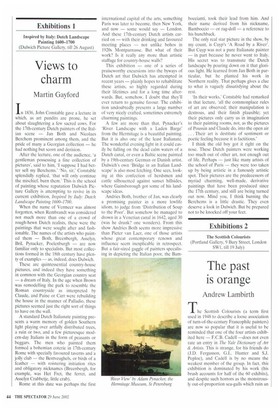Views to charm
Martin Gaylord
In 1836, John Constable gave a lecture in which, as art pundits are prone, he set about slaughtering a few sacred cows. For the 17th-century Dutch painters of the Italian scene — Jan Both and Nicolaes Berchern prominent among them, and the pride of many a Georgian collection — he had nothing but scorn and derision.
After the lecture, one of the audience, 'a gentleman possessing a fine collection of pictures', said to him, 'I suppose I had better sell my Berchems."No, sir,' Constable splendidly replied, `that will only continue the mischief, burn them.' This is the school of painting whose reputation Dulwich Picture Gallery is attempting to revive in its current exhibition, Inspired by Italy: Dutch Landscape Painting 1600-1700.
When the name of Vermeer was almost forgotten, when Rembrandt was considered not much more than one of a crowd of rough-hewn Dutch realists, these were the paintings that were sought after and fashionable. The names of the artists who painted them — Both, Breenbergh, Asselyn, Bril, Pynacker, Poelenburgh — are now familiar only to specialists. But most collections formed in the 18th century have plen ty of examples as, indeed, does Dulwich.
These are quintessential country-house pictures, and indeed they have something in common with the Georgian country seat — a dream of Italy. In the age when Brown was remodelling the park to resemble the Roman countryside as interpreted by Claude, and Paine or Carr were rebuilding the house in the manner of Palladio, these pictures seemed just the right sort of things to have on the wall.
A standard Dutch Italianate painting presents a warm memory of golden Southern light playing over artfully distributed trees. a ruin or two, and a few picturesque modern-day Italians in the form of peasants or beggars. The men who painted them formed a bohemian coterie in 17th-century Rome with specially favoured taverns and a jolly club — the Bentveughels, or birds of a
feather with roistering initiation rites and obligatory nicknames (Breenbergh, for example, was Het Fret, the ferret, and Asselyn Crabbetje, little crab).
Rome at this date was perhaps the first international capital of the arts, something Paris was later to become, then New York, and now — some would say — London. And these 17th-century Dutch artists carried on — with their drinking and favoured meeting places — not unlike bohos in 1920s Montparnasse. But what of their work? Is it really any more than artistic staffage for country-house walls?
This exhibition — one of a series of praiseworthy excursions into the byways of Dutch art that Dulwich has attempted in recent years — plainly hopes to rehabilitate these artists, so highly regarded during their lifetimes and for a long time afterwards. But, somehow, I doubt that they'll ever return to genuine favour. The exhibition undoubtedly presents a large number of very nicely crafted, sometimes extremely charming paintings.
A few are more than that. Pynacker's 'River Landscape with a Laden Barge' from the Hermitage is a beautiful painting. But it is also one of the least Italianate. The wonderful evening light in it could easily be falling on the dead calm waters of a Dutch canal, or even a Baltic scene painted by a 19th-century German or Danish artist. Dulwich's own 'Bridge in an Italian Landscape' is also most fetching. One sees, looking at this confection of herdsmen and cattle silhouetted against sunset hillsides, where Gainsborough got some of his landscape ideas.
Andries Both, brother of Jan, was clearly a promising painter in a more lowlife idiom, to judge from 'Distribution of Soup to the Poor'. But somehow he managed to drown in a Venetian canal in 1642, aged 30 (was he drunk? one wonders). From this show Andries Both seems more impressive than Pieter van Laer, one of those artists whose great contemporary renown and influence seem inexplicable in retrospect. But a fair-sized gaggle of painters specalising in depicting the Italian poor, the Barn
boccianti, took their lead from him. And their name derived from his nickname, Bamboccio — or rag-doll — a reference to his hunchback.
The only real star picture in the show, by my count. is Cuyp's 'A Road by a River'. But Cuyp was not a pure Italianate painter — in part because he never went to Italy. His secret was to transmute the Dutch landscape by pouring down on it that glorious light. He learned from Jan Both in particular, but he planted his work in Northern reality. That perhaps gives a clue to what is vaguely dissatisfying about the rest.
'In their works,' Constable had remarked in that lecture, 'all the commonplace rules of art are observed; their manipulation is dextrous, and their finish plausible; yet their pictures only carry us in imagination to their painting rooms, not, as the pictures of Poussin and Claude do, into the open air . . . Their art is destitute of sentiment or poetic feeling because it is factitious.'
I think the old boy got it right on the nose. These Dutch painters were working too much out of other art, not enough out of life. Perhaps — just like many artists of the school of Paris — they were too taken up by being artistic in a famously artistic spot. Their pictures are the predecessors of myriad charming, well-made, derivative paintings that have been produced since the 17th century, and still are being turned out now. Mind you, I think burning the Berchems is a little drastic. They even deserve a look in Dulwich. But be prepared not to be knocked off your feet.


































































 Previous page
Previous page